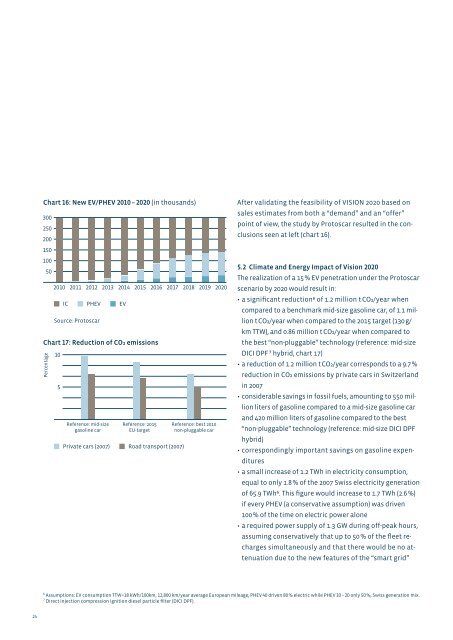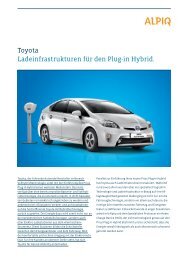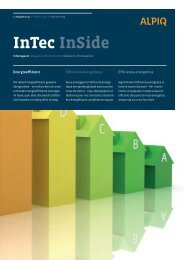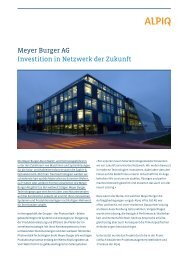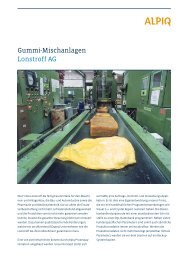Electric vehicle market penetration in Switzerland by 2020 - Alpiq
Electric vehicle market penetration in Switzerland by 2020 - Alpiq
Electric vehicle market penetration in Switzerland by 2020 - Alpiq
- No tags were found...
You also want an ePaper? Increase the reach of your titles
YUMPU automatically turns print PDFs into web optimized ePapers that Google loves.
Chart 16: New EV/PHEV 2010 – <strong>2020</strong> (<strong>in</strong> thousands)300250200150100502010 2011 2012 2013 2014 2015 2016 2017 2018 2019 <strong>2020</strong>IC PHEV EVSource: ProtoscarChart 17: Reduction of CO2 emissionsPercentage105Reference: mid-sizegasol<strong>in</strong>e carReference: 2015EU-targetPrivate cars (2007) Road transport (2007)Reference: best 2010non-pluggable carAfter validat<strong>in</strong>g the feasibility of VISION <strong>2020</strong> based onsales estimates from both a “demand” and an “offer”po<strong>in</strong>t of view, the study <strong>by</strong> Protoscar resulted <strong>in</strong> the conclusionsseen at left (chart 16).5.2 Climate and Energy Impact of Vision <strong>2020</strong>The realization of a 15 % EV <strong>penetration</strong> under the Protoscarscenario <strong>by</strong> <strong>2020</strong> would result <strong>in</strong>:• a significant reduction6 of 1.2 million t CO2/year whencompared to a benchmark mid-size gasol<strong>in</strong>e car, of 1.1 milliont CO2/year when compared to the 2015 target (130 g/km TTW), and 0.86 million t CO2/year when compared tothe best “non-pluggable” technology (reference: mid-sizeDICI DPF 7 hybrid, chart 17)• a reduction of 1.2 million t CO2/year corresponds to a 9.7 %reduction <strong>in</strong> CO2 emissions <strong>by</strong> private cars <strong>in</strong> <strong>Switzerland</strong><strong>in</strong> 2007• considerable sav<strong>in</strong>gs <strong>in</strong> fossil fuels, amount<strong>in</strong>g to 550 millionliters of gasol<strong>in</strong>e compared to a mid-size gasol<strong>in</strong>e carand 420 million liters of gasol<strong>in</strong>e compared to the best“non-pluggable” technology (reference: mid-size DICI DPFhybrid)• correspond<strong>in</strong>gly important sav<strong>in</strong>gs on gasol<strong>in</strong>e expenditures• a small <strong>in</strong>crease of 1.2 TWh <strong>in</strong> electricity consumption,equal to only 1.8 % of the 2007 Swiss electricity generationof 65.9 TWh6. This figure would <strong>in</strong>crease to 1.7 TWh (2.6 %)if every PHEV (a conservative assumption) was driven100 % of the time on electric power alone• a required power supply of 1.3 GW dur<strong>in</strong>g off-peak hours,assum<strong>in</strong>g conservatively that up to 50 % of the fleet rechargessimultaneously and that there would be no attenuationdue to the new features of the “smart grid”6Assumptions: EV consumption TTW=18 kWh/100km, 12,800 km/year average European mileage, PHEV 40 driven 80 % electric while PHEV 10 – 20 only 50 %, Swiss generation mix.7Direct <strong>in</strong>jection compression ignition diesel particle filter (DICI DPF).24


